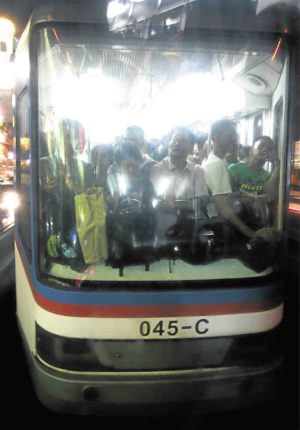Just a day after the management of the Metro Rail Transit 3 (MRT 3) announced that it had managed to increase to 10 the number of operational trains, the count slid down to single digits again.
At 5:13 p.m. on Monday, the number of running trains went down to eight after a southbound train encountered a signaling error. The MRT 3 management said in an advisory that this might have been due to worn-out signaling sub-components such as the sensor.
It noted, however, that the 350 affected passengers were able to get on the next train which arrived within nine minutes.
The off-loading incident came just a day after the MRT management announced that it was finally able to deploy 10 trains, the first time in a month that the number of operational trains reached double digits.
The figure, however, went down to eight yesterday. There was no announcement on what happened to the other train.
Worry-free weekends
Just last week, the MRT 3 ended a nine-day streak of not experiencing any off-loading incident. This came to an end on March 4 when a train was forced to unload passengers, just two days after management expressed gratitude for the “worry-free week” which it hailed as an “all-time high” accomplishment.
While for some time the MRT 3 ran 10 trains, it was still short of the Department of Transportation’s (DOTr) lowered and self-imposed target of 12 trains. Initially, when it took over as the MRT 3 interim maintenance provider in November, the DOTr set at 15 the ideal number of trains that should be operational daily.
The figure was lower by five trains from the 20 it required previous MRT 3 maintenance provider, Busan Universal Rail Inc. to keep in running condition. The last time that the MRT 3 had 10 trains in operation was on Feb. 4.
Since there were only seven to nine trains running last month, the average number of passengers dropped to 236,000, almost half of last year’s average of 463,000.At one point, only six trains were functional.
On the other hand, the Light Rail Transit 1 (LRT 1) saw its average number of passengers in December and January increase by 20,000 passengers daily. In January, it had an average of 510,000 passengers.
While they have yet to conduct a scientific study on why their ridership increased, Rochelle Hilario, Light Rail Manila Corp.’s corporate communications head, attributed the growth to the government’s “Tanggal Bulok, Tanggal Usok” campaign, as well as to the MRT 3’s lack of trains.
Extensive maintenance check
Transportation Secretary Arthur Tugade earlier said that they might have just been “lucky” when there were no recorded unloading incidents at the MRT 3. After the Holy Week break, the transport chief noted that they were targeting to raise to 15 the number of working trains.
The MRT 3 will undergo an extensive maintenance check from Holy Wednesday to Easter Sunday.
On Saturday, TUV Rheinland is expected to come out with its independent audit of the 48 Dalian trains purchased by the Aquino administration.
Should it clear the P3.8-billion trains for use by the public following minor adjustments, the MRT management had said that they would be rolled out to help improve the system’s reliability.
